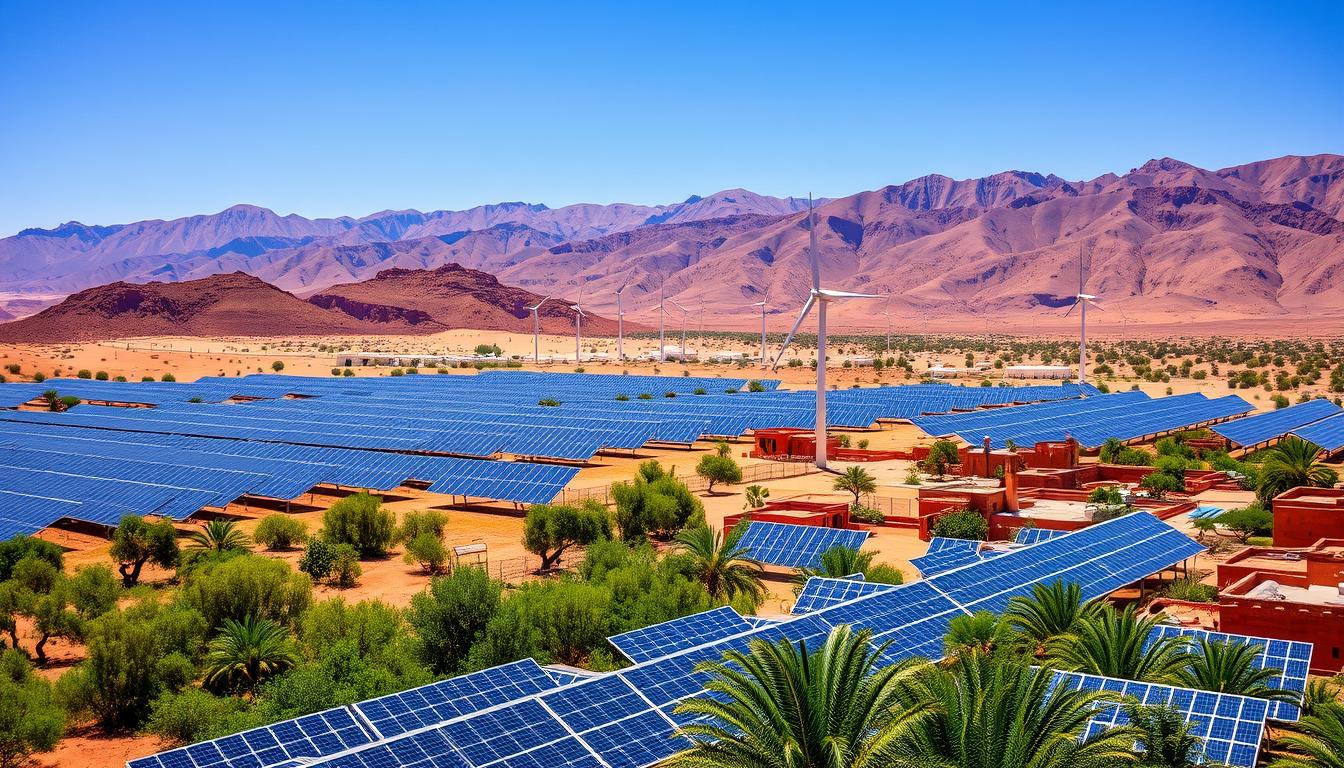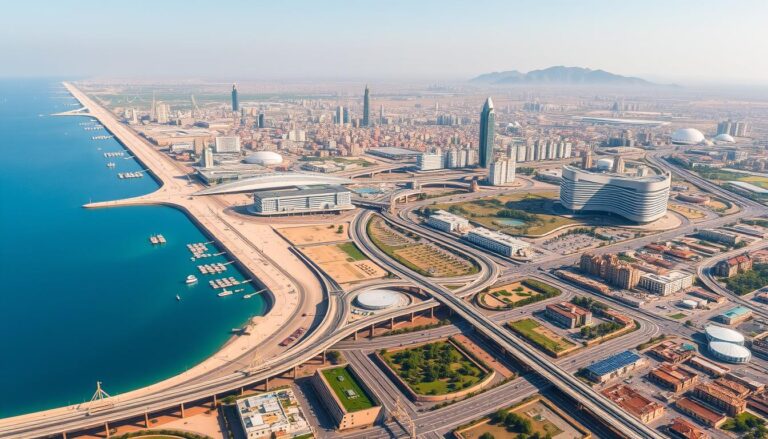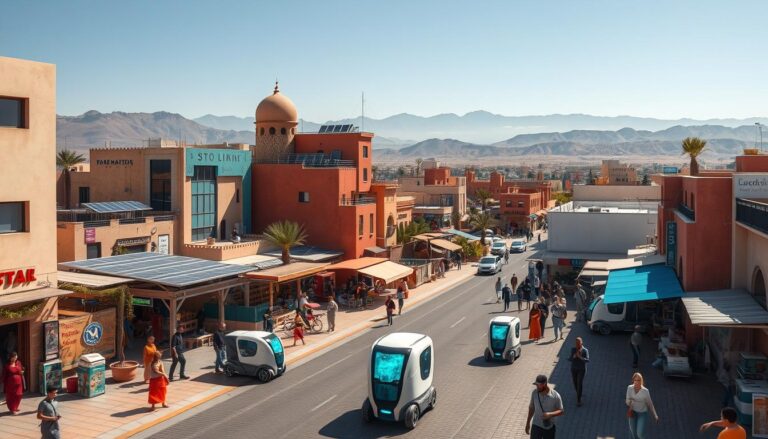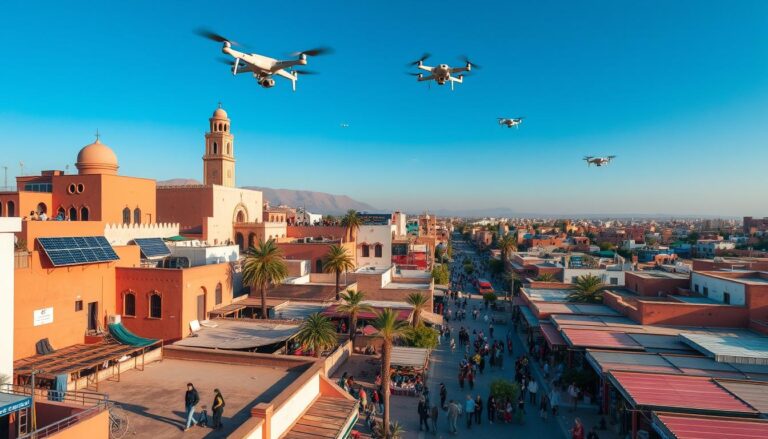What if Morocco, known for its historical cities and deserts, could become a global powerhouse in renewable energy?
Morocco’s goal is not just ambitious; it’s a national strategy to change its energy landscape. The country currently imports most of its energy, about 90%. But it aims to use over 52% of its energy from renewable sources by 2030. This move shows Morocco’s strong commitment to reduce imports and increase domestic energy production.
The Moroccan Agency for Sustainable Energy (MASEN) plays a key role in this vision. It supports private renewable energy projects. Morocco plans to use 100% renewable energy by 2050, focusing on solar, wind, and green hydrogen. Laws 13-09 and 48-15 help these efforts, encouraging private sector involvement and ensuring a stable electrical system.
Morocco aims to add 10 GW of renewable energy by 2030. This includes 4.6 GW from solar, 4.2 GW from wind, and 1.1 GW from hydropower. The country also plans to cut greenhouse gas emissions by 18.3% by 2030, meeting global standards.
Morocco expects its electricity demand to grow from 35 TWh in 2016 to 80-170 TWh by 2050. This will require around USD 30 billion in investment, mainly for renewable energy. The funding will come from both public and private sources, including international banks.
The renewable energy sector could create over 400,000 jobs by 2040. Morocco is also working with the EU and Africa to lead in clean energy. This includes the Morocco-EU Green Deal.
Morocco is a model for Africa, showing how ambitious projects can lead to a sustainable future. Its success could inspire other countries to follow a similar path.
The Role of Solar Energy in Morocco’s Renewable Energy Vision
Morocco is leading the way in renewable energy with big investments in solar power. The Noor Ouarzazate solar complex is a key example of this commitment to green energy.
Noor Ouarzazate Solar Complex
The Noor Ouarzazate solar complex is a huge solar power project in Morocco. It’s managed by the Moroccan Agency for Sustainable Energy (MASEN). This complex will have a capacity of about 580 MW.
It’s a big step towards reducing carbon emissions. It shows Morocco’s strong commitment to clean energy.
Photovoltaic Solar Energy Projects
Morocco is also growing its photovoltaic solar energy projects. These projects help reach the goal of 52% renewable energy by 2030. By using photovoltaic solar energy in Morocco, the country wants to increase energy production.
It aims to make energy more available and reliable everywhere.
Impact on Energy Prices and Availability
Morocco’s solar projects are changing energy prices and availability. Solar energy has made electricity cheaper for people. This helps the economy grow and reduces the need for imported fossil fuels.
Wind Energy Development in Morocco
Wind energy is key to Morocco’s plan to grow renewable energy. The country is investing a lot in this area. It wants to use less fossil fuels and cut down on carbon emissions.
The government has big goals to increase wind energy. It aims to make Morocco a leader in clean energy. This will provide a steady and green energy source for the future.
Installed Wind Capacity and Future Projects
Morocco leads in wind energy in Africa. It plans to grow its wind power even more. The country’s location is perfect for wind farms.
The Ministry of Energy has big plans for wind energy. It wants to build more wind farms, both on land and in the sea. The Essaouira offshore wind project is a major step in this direction.
Potential for Wind Power Expansion
Morocco has a huge chance to grow its wind power. Experts think it could reach up to 25,000 MW. This would make Morocco a top player in renewable energy.
The World Bank Group sees a lot of potential for offshore wind. Morocco’s Atlantic coast is ideal for wind farms. This could unlock a lot of energy.
Morocco also wants to make its wind energy sector better. It plans to invest and partner with others. This will improve energy security, create jobs, and drive economic growth.
Hydropower Contributions to Renewable Energy in Morocco
Morocco is making big strides in renewable energy thanks to hydropower. The country uses its geography to its advantage. This makes Morocco a leader in sustainability.
Existing Hydropower Infrastructure
Morocco’s hydropower is key to reaching its renewable energy goals. Traditional plants help meet energy needs. They are crucial for Morocco’s aim of 52% renewable energy by 2025.
New Pumped Energy Transfer Stations
Morocco is also introducing new pumped energy transfer stations. These are part of its renewable energy policy. The €284 million hydroelectric plant near Agadir and Afourar PETS are major advancements.
These projects do more than just generate power. They also help with energy storage and keeping the grid stable. Morocco’s efforts show its strong commitment to a green energy future.
Energy Efficiency Initiatives in Morocco
Morocco is working hard to be more energy sustainable. They focus on energy efficiency in Morocco as well as renewable energy. Their goal is to cut energy use by 15 percent by 2030. They’re working in many areas like transportation, industry, and public lighting.
Upgrading public lighting is a big part of their plan. They want to use less energy. The industrial sector is also changing, with new energy-saving machines and processes.
In transportation, they encourage electric vehicles and build more charging stations. This helps reduce pollution and makes the grid more stable.
The construction industry is also getting greener. New buildings must follow strict energy-saving rules. This helps save energy in the long run.
Morocco’s efforts in clean energy initiatives in Morocco are making a big difference. They’re moving towards a future where energy efficiency is common in all sectors. This supports their energy strategy and helps the economy become greener.
Green Hydrogen: A New Horizon for Morocco
Morocco is on a big journey to a sustainable future. It’s focusing on green energy, especially green hydrogen. This could change the country’s energy scene a lot.
Green Hydrogen Roadmap
The Morocco’s green hydrogen roadmap says it needs $76 billion from 2020 to 2050. This money will go to renewable energy, electrolysers, and conversion plants. Morocco has set aside nearly one million hectares of land for green hydrogen projects.
Domestic and International Demand
Morocco is well-placed to be a green hydrogen hub. It has a big maritime infrastructure and is close to Europe. Almost 100 investors want to make green hydrogen here, showing strong demand.
The Maghreb Europe Gas Pipeline (GME) can help export hydrogen to Spain. This makes Morocco even more appealing for green hydrogen projects.
Infrastructure and Financing
The Moroccan government is leading the way with “Morocco’s Offer” for green hydrogen. It includes projects from renewable electricity to converting hydrogen into other fuels. They’re also looking into green bonds to get more investment.
Morocco is investing in green energy and working with private companies. It wants to be a key player in the global renewable energy market.
Public and Private Sector Collaboration
In Morocco’s quest for a green energy future, teamwork between public and private groups is key. The country aims to hit a 42% renewable energy goal by 2020. Now, it’s shooting for 52% by 2030, thanks to strong partnerships and global backing.
Role of MASEN
MASEN is a major force in Morocco’s green energy push. It leads in setting up partnerships between public and private sectors. For example, the Noor I project shows how MASEN and private funds can work together, covering 20% of costs.
MASEN is a key player in making renewable energy projects work. It helps lower costs and makes projects viable.
International Partnerships and Investments
Foreign investment is vital for Morocco’s green energy dreams. Global players and organizations bring in money, tech, and know-how. In 2022, private sector investment in green projects was expected to grow four times since 2009.
The Moroccan government offers tax breaks and subsidies to attract more foreign investment. This makes Morocco a great place for green energy projects.
Morocco’s green energy scene is boosted by big international partnerships. The Tarfaya Wind Farm is a prime example. It shows how teamwork can lead to success.
These partnerships are crucial for Morocco’s goal of becoming a green energy leader. They promise a bright future for the country’s green energy sector.
Renewable Energy Policy and Regulatory Framework in Morocco
Morocco has made big strides in creating a strong renewable energy policy. The rules are designed to help grow renewable energy projects. This includes solar, wind, and hydropower. Morocco aims to lead in clean energy.
Laws and Amendments Supporting Renewable Energy
The Moroccan government has passed key laws for renewable energy. A 2010 law covers solar, wind, and more. Law 13-09 lets private investors sell up to 20% of their energy to the grid.
This law also helps with solar and wind power. It makes it easier for these projects to connect to the grid.
There are rules for energy production facilities. Small setups need a simple declaration. But bigger ones need formal approval.
Institutional Support and Oversight
Institutional support for renewable energy in Morocco is crucial. The National Agency of Electricity Regulation (ANRE) oversees these projects. They make sure projects meet national standards.
ANRE works with other groups to help renewable energy grow. They guide both private and public sectors. This support is key for Morocco’s energy transition.
Morocco is leading in renewable energy thanks to strong laws and support. This will help Morocco grow sustainably and prosper.
Challenges and Opportunities in Achieving Morocco’s Renewable Energy Vision
Morocco is moving towards using more renewable energy, which is a big change. This change could bring many benefits. But, it also faces some big challenges that need to be solved.
Technical and Financial Challenges
Technical and financial issues are the main hurdles in Morocco’s renewable energy journey. Solving these problems is key to making renewable projects work.
Getting enough money is a big challenge. Morocco needs about USD 30 billion to support renewable energy. The high cost of renewable tech makes it hard to invest.
Also, different costs for different renewable techs mean we need a special plan for energy policy.
Potential Economic and Social Benefits
Despite the challenges, renewable energy in Morocco offers many chances for growth. Investing in renewable energy can help everyone get access to energy. It can also create more jobs and make the economy stronger.
Renewable energy can also help reduce harmful emissions. Morocco wants to cut greenhouse gas emissions by 45.5 percent by 2030.
Programs like the “Cooperative Resilience Program” help rural areas deal with climate change. This supports the economy and society. Morocco aims to use 52 percent of renewables by 2030. This shows how renewable energy can change the country for the better.
Conclusion
In recent years, Morocco has become a leader in renewable energy. It has made big steps forward, using solar, wind, and water power. This move is part of a global trend, with clean energy investments going up by 40% from 2020 to 2023.
Morocco faces challenges, like rising temperatures affecting solar and water power. But, it’s working on solutions to keep moving forward. The goal is to use more renewable energy, aiming for 52% by 2030.
Morocco is also exploring green hydrogen, showing it’s ahead in new energy fields. It’s doing this with help from international partners. This shows Morocco’s commitment to a sustainable future.
The country’s success comes from combining new technology, partnerships, and good rules. This approach makes Morocco a role model for others. It’s not just good for the environment but also for the economy, showing Morocco’s vision for a better world.
Source Links
- Morocco’s sustainable energy transition and the role of financing costs: a participatory electricity system modeling approach – Energy, Sustainability and Society
- Morocco making waves with its green energy progress
- Long before the pandemic, Morocco established a development model based on renewable energies and a sustainable vision
- How Morocco went big on solar energy
- Morocco – Energy
- Harnessing the Sun and Wind: Morocco’s Renewable Energy Revolution
- The Rise of Renewable Energy in Morocco – Alafarika for Studies and Consultancy
- Morocco’s Ambitious Offshore Wind Energy Plans
- Renewable Energy and Economic Growth in Morocco
- Towards a large-scale integration of renewable energies in Morocco
- A shining example of green energy in Morocco
- Renewable energy in emergent countries: lessons from energy transition in Morocco – Energy, Sustainability and Society
- Green Hydrogen market in Morocco: needs and barriers
- "Morocco’s Offer" underway to develop the green hydrogen sector
- Morocco: Turning a Commitment to Clean Energy into Reality
- Investment Opportunities in Morocco’s Energy Sector
- Morocco’s Energy Transition: Prioritizing Natural Gas, Embracing Green Hydrogen, and Global Collaboration at COP28
- Law 13-09 on renewable energy, regulated by Decree 2-10-578 and amended by law 58-15 – Climate Change Laws of the World
- Sustainable Transformation of Morocco’s Energy System
- Climate Challenges & Opportunities in Morocco and Beyond
- Just Energy Transitions? Lessons From Oman and Morocco
- Climate Resilience for Energy Transition in Morocco – Analysis – IEA

The Editorial Team is a passionate group of Morocco enthusiasts dedicated to sharing the beauty, culture, and wonders of this captivating country. With diverse backgrounds and a deep love for travel, we strive to bring you engaging and informative content that inspires your Moroccan adventures. From uncovering hidden gems and sharing local insights to exploring mouthwatering cuisine and showcasing the vibrant lifestyle, our team is committed to providing you with valuable resources and exciting stories that enhance your exploration of Morocco. Join us on this journey as we celebrate the rich heritage and unforgettable experiences that make Morocco truly special.





